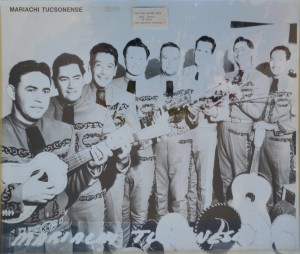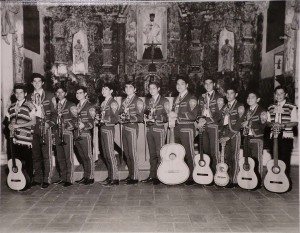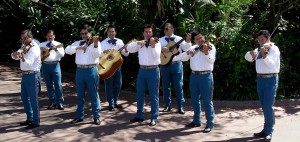Documentary on the rise of the mariachi movement in Tucson begins

555 players break the Guiness World Book record for the largest mariachi ensemble performance at the 2010 Tucson International Mariachi Conference.
Want to make a tax deductible donation to the film? Click here!
To view a five minute trailer on the film click here.
Daniel Buckley has begun production on the sixth installment of the Cine Plaza at the Fox documentary series, this time investigating how mariachis and folklórico dancers have transformed Tucson, and how in the process, Tucson has transformed the mariachi and folklórico worlds.. (Follow progress on the Mariachi Documentary Blog or visit the Facebook page). The film and book project is titled The Mariachi Miracle.
Since his start at the Tucson Citizen in 1987 and before at the Tucson Weekly, Buckley has written about mariachis, the Tucson International Mariachi Conference and the larger Latino cultural scene.
As no writer in Tucson had, he observed and commented on the evolution of mariachi and folklorico culture, and researched its roots. In 2013 Buckley was inducted into the Mariachi Hall of Fame.
With the 30th anniversary of the Tucson International Mariachi Conference held in 2011 and the upcoming 50th anniversary of America’s first youth mariachi – Tucson’s Los Changuitos Feos (The Ugly Little Monkeys) coming in 2014, a 2016 production date for The Mariachi Miracle seemed ripe.
Adding to that is the sense that the pioneers of the music who planted the seeds of mariachi in Tucson – the members of Mariachi Los Tucsonense – have largely died off, and many of the people who carried on from there are likewise of advanced age.
Why is Tucson important and what about mariachi music and dance has changed this city? These are some of the questions that will be explored in the film.
But just taking the Changuitos Feos as an example, when that youth mariachi started in 1964, young Hispanic students in Tucson were punished at school when they spoke Spanish. Most of the first boys originally recruited did not know any Spanish. Their parents spoke English only with them so that they would not be punished for speaking Spanish as those parents had been when they were kids.
Moreover, in 1964 the city was systematically eradicating evidence of Tucson’s Spanish and Mexican heritage through its “urban renewal” program, tearing down barrios to build a convention center and wiping out Mexican businesses in the downtown.
Taken in the broader context of where Tucson was at that time, Mexican culture was not only undervalued but systematically put down in the prevailing culture. Plans were being put into action to tear down the old barrios and cultural centers of Tucson’s Mexican American population to make room for the Convention Center and courts buildings, all under the justification of turning Tucson into a modern city. Even the remaining vestiges of Tucson’s colonial presidio fort were bulldozed in that period.
In the midst of all of this along comes this youth mariachi – Los Changuitos Feos. Suddenly these kids are being encouraged to learn Spanish and to sing the songs of their fore bearers. They become a tiny cultural lamp and a focal point of pride among the Mexican American community.
The Changos travel the U.S. and the world as cultural ambassadors, and its young members see the world in ways their parents could never imagine. Moreover, the group charges for its performances and the money is invested so that each student member will have a college scholarship to the Arizona college of their choice. This is huge as it means that for many, they become the first generation of their families to receive a college education.
Soon mariachi programs are starting in the schools, beginning with Davis Bilingual Elementary School. The music connects the students with their culture, their history and their families in ways no ordinary elementary school band or orchestra program had. The students want to come to school. They learn more and are more involved with their education. So dropout rates diminish in schools with these programs, while graduation rates and scholarships to college increase. It’s more than a music program. It’s a movement.
We now have generations of kids – Hispanic and not – who have become part of mariachi programs in their schools or in private organizations. In the mariachi one learns teamwork and discipline. As Father Rourke, who founded Los Changuitos Feos used to say, “You can be cute for a minute and then you have to know how to play.”
In addition these kids learn how to express themselves in front of large groups of people. That is a very powerful tool.
The first generation of Changuitos went on graduated and did great things. Several of the members founded Mariachi Cobre (Copper), and that group has gone on to be acknowledged as among the greatest mariachis now just in America but in the world. It has recorded and toured with the Boston Pops and performed with dozens of orchestras around the country. It helped to create the Tucson International Mariachi Conference – currently the longest continuously active mariachi conference on the planet, and one of the most influential in the U.S. and Mexico. But Cobre is most known for its role as the house band of the Mexico pavilion at Disney’s Epcot Center in Orlando, Florida where it likely introduces more of the world to mariachi music than any group in history.
Other former Changuitos include former Arizona state senator Frank Felix, physician David Ruiz, and educator Jeff Nevin who created the first college accredited mariachi program in America. The group goes on, as do hundreds more like it in the Tucson school systems and other organizations, giving generations of kids a pride in their culture and the tools they’ll need to succeed in any life venture they might choose to undertake.
The Tucson International Mariachi Conference furthermore has advanced mariachi music and folklórico dance. Being at her hometown conference and meeting with the great Lola Beltran and Mariachi Vargas is what set Linda Ronstadt on the course of recording her own collections of mariachi ranchera songs – in spite of her label’s prediction that they would be a complete flop and a disastrous career move. Instead they were multi-million sellers that revitalized the music both in America and in Mexico. Ronstadt in turn fortified the conference’ notion that folklórico dance was an equal partner with the song. This music was written for both and both should be taught side by side, she insisted.
Moreover, the conference steadily raised the bar for performance quality. Year after year, at younger and younger ages, mariachi students inspired and taught in workshops by the masters of their music and spurred on by peers from other communities achieved a higher and higher level of artistic expression. Today is about more than those notes and the words. It’s about idiomatic expression, performance style and innovation. It’s not a handful of songs that they all play but a huge repertoire that all know, draw from and add to. It is a vibrant cultural outpouring.
And these quick anecdotes are just the tip of the iceberg. The story of the mariachi in Tucson is a complex and inspiring tale.
Over the next two years, Buckley (and a group of paid interns) will interview the people who live the mariachi experience from its earliest days through its various intersections with education, politics and more. It will show what the music has traditionally meant to the culture and what it has come to mean. And it will celebrate Tucson’s unique place in the evolution of this music as a cultural and political force in America and Mexico.
With $5,000 from the Tucson Pima Arts Council’s PLACE initiative, Buckley has gotten the project underway. In late June, 2013 he raised another $15,000 through the crowd funding agent, “Kickstarter,” and received another $4,000 from Pima County to pay interns to work on the film. He is raising additional funds where possible toward the $250,000-$500,000 the film is expected to cost.
A special fund is being set up through the La Frontera behavioral health center, which the Tucson International Mariachi Conference helps support. If you’d like to support this film, write a check in any amount to La Frontera Arizona Inc. and write in the subject line “Mariachis Transform Tucson – Daniel Buckley.” Your donations will be tax deductible. Send the check to:
La Frontera Arizona, Inc.
Attn. Kathy Wells
504 W 29th Street
Tucson, AZ 85713-3353
Buckley plans to follow the film with a book on the topic, intending to follow that with research on how mariachis have sprung up around the United States.




[…] creating this new documentary on the rise of mariachi and folklórico culture in Tucson, I am not trying to suggest that the […]
» Toward a local and national mariachi chronology Daniel Buckley Arts said this on January 6, 2013 at 12:44 am |